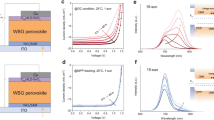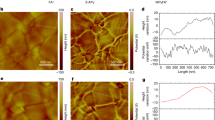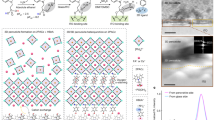Abstract
Three-dimensional/low-dimensional perovskite solar cells afford improved efficiency and stability. The design of low-dimensional capping materials is constrained to tuning the A-site organic cation, as Pb2+ and Sn2+ are the only options for the metal cation. Here we unlock access to a library of low-dimensional capping materials with metal cations beyond Pb2+/Sn2+ by processing a full precursor solution containing both metal and ammonium halides. This enables easier synthetic control of the low-dimensional capping layer and greater versatility for low-dimensional interface engineering. We demonstrate that a zero-dimensional zinc-based halogenometallate (PEA2ZnX4; PEA = phenethylammonium, X = Cl/I) induces more robust surface passivation and stronger n–N isotype three-dimensional/low-dimensional heterojunctions than its lead-based counterpart. We exhibit p–i–n solar cells with 24.1% efficiency (certified 23.25%). Our cells maintain 94.5% initial efficiency after >1,000 h of operation at the maximum power point. Our findings expand the material library for low-dimensional interface engineering and stabilization of highly efficient three-dimensional/low-dimensional perovskite solar cells.
This is a preview of subscription content, access via your institution
Access options
Access Nature and 54 other Nature Portfolio journals
Get Nature+, our best-value online-access subscription
$29.99 / 30 days
cancel any time
Subscribe to this journal
Receive 12 digital issues and online access to articles
$119.00 per year
only $9.92 per issue
Buy this article
- Purchase on Springer Link
- Instant access to full article PDF
Prices may be subject to local taxes which are calculated during checkout




Similar content being viewed by others
Data availability
All of the data needed to evaluate the conclusions in this study are included in the article, its Supplementary Information and Source Data. The data that support the findings of this study are openly available in DR-NTU (Data) at https://doi.org/10.21979/N9/G6R8YG. Source Data are provided with this paper.
References
Zhang, T. et al. Stable and efficient 3D–2D perovskite-perovskite planar heterojunction solar cell without organic hole transport layer. Joule 2, 2706–2721 (2018).
Jung, E. H. et al. Efficient, stable and scalable perovskite solar cells using poly(3-hexylthiophene). Nature 567, 511–515 (2019).
Jiang, Q. et al. Surface passivation of perovskite film for efficient solar cells. Nat. Photon. 13, 460–466 (2019).
Wang, Y. et al. Thermodynamically stabilized β-CsPbI3-based perovskite solar cells with efficiencies >18%. Science 365, 591–595 (2019).
Jang, Y.-W. et al. Intact 2D/3D halide junction perovskite solar cells via solid-phase in-plane growth. Nat. Energy 6, 63–71 (2021).
Xue, J. et al. Reconfiguring the band-edge states of photovoltaic perovskites by conjugated organic cations. Science 371, 636–640 (2021).
Zhang, F. et al. Metastable Dion–Jacobson 2D structure enables efficient and stable perovskite solar cells. Science 375, 71–76 (2022).
Yang, G. et al. Stable and low-photovoltage-loss perovskite solar cells by multifunctional passivation. Nat. Photon. 15, 681–689 (2021).
Tan, S. et al. Stability-limiting heterointerfaces of perovskite photovoltaics. Nature https://doi.org/10.1038/s41586-022-04604-5 (2022).
Azmi, R. et al. Damp heat-stable perovskite solar cells with tailored-dimensionality 2D/3D heterojunctions. Science 376, 73–77 (2022).
Grancini, G. & Nazeeruddin, M. K. Dimensional tailoring of hybrid perovskites for photovoltaics. Nat. Rev. Mater. 4, 4–22 (2018).
Li, X., Hoffman, J. M. & Kanatzidis, M. G. The 2D halide perovskite rulebook: how the spacer influences everything from the structure to optoelectronic device efficiency. Chem. Rev. 121, 2230–2291 (2021).
Zhang, F. et al. Advances in two-dimensional organic–inorganic hybrid perovskites. Energy Environ. Sci. 13, 1154–1186 (2020).
Choi, H. S. & Kim, H. S. 3D/2D bilayered perovskite solar cells with an enhanced stability and performance. Materials 13, 3868 (2020).
Mahmud, M. A. et al. Origin of efficiency and stability enhancement in high‐performing mixed dimensional 2D–3D perovskite solar cells: a review. Adv. Funct. Mater. 32, 2009164 (2021).
Wu, G. et al. Surface passivation using two dimensional perovskites towards efficient and stable perovskite solar cells. Adv. Mater. 34, 2105635 (2021).
Bai, Y. et al. Dimensional engineering of a graded 3D–2D halide perovskite interface enables ultrahigh VOC enhanced stability in the p–i–n photovoltaics. Adv. Energy Mater. 7, 1701038 (2017).
Ye, T. et al. Efficient and ambient-air-stable solar cell with highly oriented 2D@3D perovskites. Adv. Funct. Mater. 28, 1801654 (2018).
Alharbi, E. A. et al. Atomic-level passivation mechanism of ammonium salts enabling highly efficient perovskite solar cells. Nat. Commun. 10, 3008 (2019).
Liu, Y. et al. Ultrahydrophobic 3D/2D fluoroarene bilayer-based water-resistant perovskite solar cells with efficiencies exceeding 22%. Sci. Adv. 5, eaaw2543 (2019).
Zhu, H. et al. Tailored amphiphilic molecular mitigators for stable perovskite solar cells with 23.5% efficiency. Adv. Mater. 32, 1907757 (2020).
Yang, B. et al. Interfacial passivation engineering of perovskite solar cells with fill factor over 82% and outstanding operational stability on n–i–p architecture. ACS Energy Lett. 6, 3916–3923 (2021).
Li, F. et al. Regulating surface termination for efficient inverted perovskite solar cells with greater than 23% efficiency. J. Am. Chem. Soc. 142, 20134–20142 (2020).
Rademeyer, M., Tsouris, C., Billing, D. G., Lemmerer, A. & Charmant, J. Robust motifs in 2-phenylethylammonium and related tetrahalometallates. CrystEngComm 13, 3485–3497 (2011).
Qin, C. et al. Stable room-temperature continuous-wave lasing in quasi-2D perovskite films. Nature 585, 53–57 (2020).
Liang, L., Luo, H., Hu, J., Li, H. & Gao, P. Efficient perovskite solar cells by reducing interface‐mediated recombination: a bulky amine approach. Adv. Energy Mater. 10, 2000197 (2020).
Itoh, K., Hinasada, A., Matsunaga, H. & Nakamura, E. Disordered structure of Rb2ZnCl4 in the normal phase. J. Phys. Soc. Jpn. 52, 664–670 (1983).
Lopez, A. & Anderson, R. L. Photocurrent spectra of Ge–GaAs heterojunctions. Solid-State Electron. 7, 695–700 (1964).
Sharma, B. L. & Purohit, R. K. Semiconductor Heterojunctions (Pergamon, 1974).
Bachmann, J. Atomic Layer Deposition in Energy Conversion Applications (John Wiley & Sons, 2017).
Wang, F. et al. Interface dipole induced field‐effect passivation for achieving 21.7% efficiency and stable perovskite solar cells. Adv. Funct. Mater. 31, 2008052 (2020).
Liu, J. et al. Efficient and stable perovskite-silicon tandem solar cells through contact displacement by MgFx. Science 377, 302–306 (2022).
Zhang, P. et al. Triethyl phosphate in an antisolvent: a novel approach to fabricate high-efficiency and stable perovskite solar cells under ambient air conditions. Mater. Chem. Front. 5, 7628–7637 (2021).
Chen, P. et al. In situ growth of 2D perovskite capping layer for stable and efficient perovskite solar cells. Adv. Funct. Mater. 28, 1706923 (2018).
Ye, S. et al. Resolving spectral mismatch errors for perovskite solar cells in commercial class AAA solar simulators. J. Phys. Chem. Lett. 11, 3782–3788 (2020).
Kiermasch, D., Gil-Escrig, L., Bolink, H. J. & Tvingstedt, K. Effects of masking on open-circuit voltage and fill factor in solar cells. Joule 3, 16–26 (2019).
Kresse, G. & Furthmüller, J. Efficient iterative schemes for ab initio total-energy calculations using a plane-wave basis set. Phys. Rev. B 54, 11169–11186 (1996).
Blochl, P. E. Projector augmented-wave method. Phys. Rev. B 50, 17953–17979 (1994).
Lee, K., Murray, É. D., Kong, L., Lundqvist, B. I. & Langreth, D. C. Higher-accuracy van der Waals density functional. Phys. Rev. B 82, 081101 (2010).
Perdew, J. P., Burke, K. & Ernzerhof, M. Generalized gradient approximation made simple. Phys. Rev. Lett. 77, 3865–3868 (1996).
Monkhorst, H. J. & Pack, J. D. Special points for Brillouin-zone integrations. Phys. Rev. B 13, 5188–5192 (1976).
Acknowledgements
This work is supported by the Ministry of Singapore under its AcRF Tier 1 (Project RG6/21 (2021-T1-001-072) to Y.M.L.) and Tier 2 grants (MOE2019-T2-1-006 to T.C.S., MOE2019-T2-1-085 to Y.M.L. and MOE-T2EP50120-0004 to T.C.S.), and the National Research Foundation (NRF) Singapore under its NRF Investigatorship (NRF-NRFI2018-04 to T.C.S.). We thank the Facility for Analysis, Characterisation, Testing and Simulation (FACTS) (Nanyang Technological University, Singapore) for allowing us to use their electron microscopy, UPS instrument and X-ray facilities. We also thank the Solar Energy Research Institute of Singapore (SERIS) for PV authentication tests. We would like to thank Professor J. Bisquert (Universitat Jaume I) for the discussion on Mott–Schottky analysis. The computational work for this article was fully performed on resources of the National Supercomputing Centre, Singapore (https://www.nscc.sg).
Author information
Authors and Affiliations
Contributions
T.C.S., Y.M.L., S.Y. and H.R. conceived the idea for the manuscript and designed the experiments. S.Y. and H.R. performed sample preparation, device fabrication, optimization and characterization. M.F. and Y.G. conducted the TRPL measurements. Z.Y. and S.T. performed the UPS measurements. L.X. prepared the sample lamella by FIB. L.X. and C.B. conducted the TEM measurements. B.C. performed the SEM measurements. S.Y. and Q.Z. performed the KPFM measurements. H.R. conducted the XRD and GIWAXS measurements. D.H.L.S. conducted the TOF-SIMS measurements. Q.X. performed DFT calculations. B.W. performed the photoluminescence imaging analysis. H.H., Y.W. and X.X assisted device fabrication. All of the authors were involved in discussions of data analysis and commented on the manuscript. T.C.S., Y.M.L., S.Y. and H.R. wrote and revised the manuscript. T.C.S. and Y.M.L. led the project.
Corresponding authors
Ethics declarations
Competing interests
The authors declare no competing interests.
Peer review
Peer review information
Nature Energy thanks Wanyi Nie and the other, anonymous, reviewer(s) for their contribution to the peer review of this work.
Additional information
Publisher’s note Springer Nature remains neutral with regard to jurisdictional claims in published maps and institutional affiliations.
Supplementary information
Supplementary Information
Supplementary Notes 1–4, Figs. 1–41, Tables 1–18 and references.
Supplementary Video 1
The proposed FP capping process.
Supplementary Data 1
Source Data for Supplementary Fig. 36.
Supplementary Data 2
Source Data for Supplementary Tables 5–8 and 11–17.
Source data
Source Data Fig. 4
Source Data for Fig. 4b,d.
Rights and permissions
Springer Nature or its licensor (e.g. a society or other partner) holds exclusive rights to this article under a publishing agreement with the author(s) or other rightsholder(s); author self-archiving of the accepted manuscript version of this article is solely governed by the terms of such publishing agreement and applicable law.
About this article
Cite this article
Ye, S., Rao, H., Feng, M. et al. Expanding the low-dimensional interface engineering toolbox for efficient perovskite solar cells. Nat Energy 8, 284–293 (2023). https://doi.org/10.1038/s41560-023-01204-z
Received:
Accepted:
Published:
Issue Date:
DOI: https://doi.org/10.1038/s41560-023-01204-z
This article is cited by
-
Perovskite/silicon tandem solar cells–compositions for improved stability and power conversion efficiency
Photochemical & Photobiological Sciences (2024)



